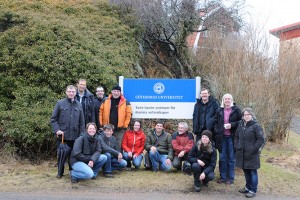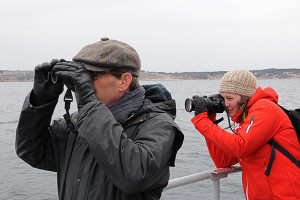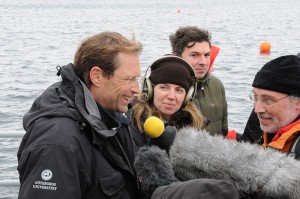They were wet. They were cold. And they were extremely happy. Towards the end of our research trip arranged for eleven German science journalists, we managed to drive them to the mesocosms onboard our working boat WASSERMANN. On the wavy fjord, beaten by the northeast, rain and hail, they took pictures of Andrea and Ulf doing CTD measurements and even did short interviews with them. A bit worried about a bunch of landlubbers being out in this kind of weather, I went to the pier to meet them after one hour – to see nothing but smiling faces. “That was the best we could do”, Ulf said with rainwater dripping from his hair.
I would say this is true for the whole project. To let journalists feel the enthusiasm of every single person involved in this long-term study, to show that collecting data is pretty hard work and to make them experience daily life at the station is really worth the effort. And a large effort was what the KOSMOS 2013 members and the team at Sven Lovén Centrum made. Thanks again, tusen tack!
We started in Kiel. GEOMAR’s director Peter Herzig welcomed our guests and gave a – not as short as planned – presentation of the institute before Ulf introduced the most important basics about ocean acidification. Questions and comments about related topics burst our schedule. But who would mind, if you break into such an interesting discussion right at the start?
With some delay, we went to meet Ralf Schwarz, Technical Head of the Technology and Logistics Centre, were the mesocosms were developed. Questions and comments burst… Well – we had enough time for lunch in the end. On the westshore, Inken Kruse and Balsam al Janabi explained the benthocosm facilities. In contrast to the mesocosms that are used to investigate changes in the water column, the benthocosms are meant for experiments with organisms living at the sea floor. In his cold, dark and narrow lab, Armin Form gave insights into his work about the effects of climate change on cold-water corals. Lophelia was just fed and in good shape. But too bad for the radio ladies that corals don’t make any noise. So the sound of opening and closing the isolation door and the bubbling in the aquaria had to complement Armin’s explanations.
Over dinner on the ferry, we came back to some questions from the morning. How can scientists make themselves heard in society? Do they have to do so? What kind of protagonists do journalists wish? What makes a great story? Time flew – and we knew a lot about each other’s work when we arrived at the station the next morning.
NEREUS, one of the larger Sven Lovén boats, was ready to cast off with us. I was about to jump from the bus and hurry onboard, feeling so glad about being back to Kristineberg and the Gullmar Fjord. But yes, of course, a hot coffee, warm clothes and all the recording and photographing equipment are good to take before leaving for this first short expedition.
Closer, they wanted to get closer. Ulf explained to the group what was going on while the KOSMOS team took samples from the mesocosms as they do regularly without worrying about being watched and photographed. But the view from NEREUS was not close enough for our reporters. It just created the desire to be in the middle of the action. And so they were. From the very nice dinner arranged by the station, we stole away to watch newly hatched cod larvae in Catriona’s, Michael’s and Martina’s experimental tanks. Or did we watch Catriona being so enthusiastic about these CO2-fed babies? Lennart and Jana ran their fancy flow cytometer detecting different plankton species and also Tim and Mathias, Dana, Maren and Thomas had company at the summer lab until late. Our really nice invasive species spread in the labs the next day as well – apart from the second Spritztour with WASSERMANN. The best thing we could do.
Here’s a selection of media coverage:
Deutschlandfunk Forschung aktuell
“Meeresbewohner im Stress-Test”
by Christine Westerhaus
Deutschlandfunk Forschung Aktuell
“Ozean im Säurestress”
by Christine Westerhaus
rbb Inforadio
“Prinzlers Forschungsreise zum Gullmarfjord”
by Thomas Prinzler
rbb Inforadio
“Der Mesokosmos ist eine Welt für sich”
by Thomas Prinzler
rbb Inforadio
“Von sauren Ozeanen und Schätzen am Meeresboden”
by Thomas Prinzler
Stuttgarter Zeitung
“Eine Reise zum Ozean der Zukunft”
by Klaus Zintz
Schweizer Radio und Fernsehen
“Ozean im Stresstest”
by Katrin Zöfel
sh:z Journal
“Zeitmaschine in den Ozean der Zukunft”
by Merle Bornemann
Nature
News in Focus
“Floating tubes test sea-life sensitivity”
by Hristio Botchev

Yes, we had a great time together: Hans-Jürgen Weyer, Ulf Riebesell, Maike Nicolai, Hristio Boytchev, Peter Friederici, Rüdiger Schacht, Merle Bornemann, Christian Heinrich, Thomas Prinzler, Klaus Zintz, Christine Westerhaus, Nicola Wettmarshausen and Katrin Zöfel (left to right). Photo: Jan Czerny, GEOMAR
By Maike Nicolai

